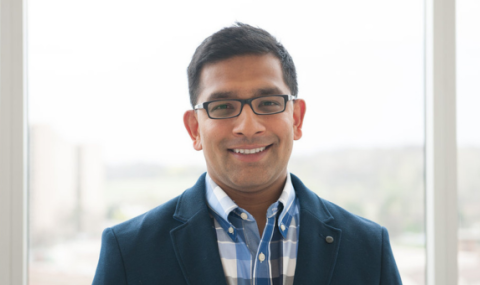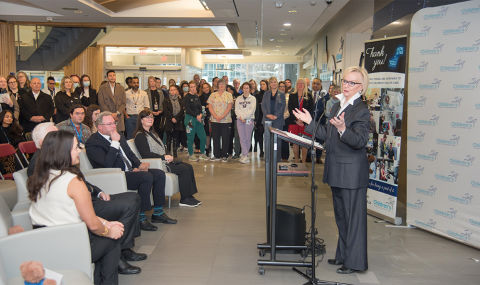History of the Multi-Organ Transplant Program
In 1972, University Hospital opened its doors and within six months surgeons had performed the hospital's first kidney transplant.
Researchers working with the LHSC Transplant Program began conducting test-tube experiments to manipulate the body's immune system and prevent organ rejection. In 1979, the drug company that discovered cyclosporine chose our hospital as one of the first centres worldwide to conduct a clinical study using this new anti-rejection medication. With the advent of cyclosporine, transplantation was on the rise.
In 1981, 14 months after the cyclosporine trials began, physicians noticed a significant decrease in organ rejection. The success of kidney transplants jumped from 50% to 80% survival one year after surgery.
London Health Sciences Centre added to kidney transplants with liver transplants (1977), heart transplants (1981), small bowel transplants (1988), and lung transplants (1989). The first bone marrow transplant at LHSC was performed in 1989 to treat a patient with leukemia.
By 1987, our hospital had established itself internationally as a centre for multi-organ transplantation. The Ministry of Health recognized this status by granting funds to build the 12-bed Multi-Organ Transplant Unit.
The creation of the renowned Walter J. Blackburn Multi-Organ Transplant Unit -- the first of its kind in Canada -- was driven by the visionary work of Dr. Cal Stiller, the first director of the transplant program. The unit was named to honour philanthropist Walter Blackburn who served as president of the London Health Association from 1969 to 1973.
On September 17, 2014, the unit was renamed the Stiller Blackburn Multi-Organ Transplant Unit to recognize the contributions of Dr. Stiller, in partnership with the Blackburn family. At the event, Dr. Stiller said "This is a tremendous honour, to share the naming of this unit with the Blackburn family is extraordinary." He also highlighted his pride in the ongoing high donation rate that the London region continues to have -- comparable to the best donation rates worldwide -- as well as our innovative research.
Our longest-surviving kidney transplant recipient is celebrating more than 40 years of healthy life. Some of our earliest patients are Canada's longest surviving liver and heart transplant recipients, now celebrating 30 years of healthy life after their transplants in the early 1980s. When the 600th heart transplant was performed at LHSC in 2012, our centre had performed more heart transplants than any other centre in Canada.
Innovation has been a hallmark of our Multi-Organ Transplant Program. To address the shortage of donated organs, surgeons at LHSC have split livers from deceased donors into two halves so each half could be transplanted into separate recipients, suitably size-matched for the grafts. In 1993, a mother donated a piece of her liver so it could be transplanted into her infant son. Seven years later, in another Canadian first, that technique was extended to adult recipients by taking the larger right half of the liver from a living donor and transplanting it into an adult recipient.
To find out more, you can read Three Decades of Transplantation, which provides an historical overview, as well as our most recent MOTP booklet that highlights our innovative clinical and research work.
Transplant Milestones
- late 1950s first kidney transplants in London are done at St. Joseph's Hospital using living-related donors
- 1972 official opening of University Hospital (UH)
- 1973 UH transplant program begins with its first kidney transplant
- 1975 first living-related kidney transplant at UH
- 1977 first liver transplant at UH
- 1979 University Hospital is chosen as one of five North American centres to conduct a patient study on the benefits and side effects of the new anti-rejection drug, cyclosporine
- 1981 first heart transplant at UH
- 1983 first heart-lung transplant in Canada is done at UH
- 1983 first pediatric heart transplant in Ontario is done at UH
- 1984 first pediatric liver transplant in Ontario is done at UH
- 1987 the Multi-Organ Transplant Unit opens, August 31
- 1988 our centre performs its first bowel transplant; that same year, we successfully perform a combined liver and bowel transplant, which is the first in the world
- 1989 our first lung transplant
- 1989 London's first bone marrow transplant
- 1990 first multi-organ transplant (liver, small bowel, stomach, and pancreas) in Canada is done at UH
- 1993 our centre performs a living-related liver transplant (mother to child), the first time that this is done in Canada
- 1994 our liver transplant program develops a clinical pathway, reducing the average length of hospital stay, the number of medical tests, and the amount of medication without affecting patient care
- 1995 University Hospital and Victoria Hospital merge as the London Health Sciences Centre (LHSC)
- 1997 domino heart-lung transplant
- 1997 our team transplants the liver, bowel, stomach, and pancreas into a 5-month-old infant, the world's youngest recipient of a multi-organ transplant
- 1997 our transplant team performs its first split-liver transplant (one liver was divided into two parts so two patients could be transplanted)
- 2000 the first adult-to-adult living liver transplant in Canada is done at our centre
- 2001 London performs its 1000th liver transplant
- 2001 en-bloc pediatric donor kidney transplant
- 2004 we perform our first kidney-pancreas transplant
- 2006 DCD (donation after circulatory death) liver & kidney donors successfully used for transplants
- 2008 DCD kidney-pancreas donor and transplant
- 2008 pediatric DCD kidney transplant
- 2010 DCD en-bloc pediatric donor kidney transplant
- 2010 VAD used to support a patient until donated heart becomes available
- 2011 one donated pancreas is split into two, allowing two patients to each receive a kidney-pancreas transplant
- 2011 Matthew Mailing Centre for Translational Transplant Studies officially opens
- 2012 600th heart transplant done, the most of any Canadian centre
- 2013 robotic-assisted, single-incision living donor kidney nephrectomy
- 2019 the Multi-Organ Transplant Program performs its 6,000 transplant
Canadian firsts
- 1956 heart valves are transplanted for the first time worldwide (Toronto, Ontario)
- 1958 living-related kidney transplant between identical twins (Royal Victoria Hospital, Montreal, Quebec)
- 1963 Canada's first successful kidney transplants using deceased donors are done in Montreal (Royal Victoria Hospital), London (St. Joseph's Hospital), and Saskatoon (St. Paul's Hospital)
- 1968 heart transplant (Montreal, Quebec)
- 1970 liver transplant (Montreal, Quebec)
- 1974 bone marrow transplant (Toronto, Ontario)
- 1983 lung transplant (Toronto, Ontario), which was the first successful lung transplant in the world
- 1983 first heart-lung transplant in Canada is done at our centre (London, Ontario)
- 1986 double lung transplant (Toronto, Ontario), the world's first successful double lung transplant
- 1990 Canada's first multi-organ transplant (liver, small bowel, stomach and pancreas) is done (London, Ontario)
- 1993 living-related liver transplant (London, Ontario) is done for the first time in Canada when a parent donates a portion of her liver to her son
- 1995 pig liver tissue is used temporarily to keep a patient alive until a human liver became available for transplant (Montreal, Quebec)
- 1999 first double lung transplant using living donors (two people each donated part of a lung to the recipient) (Winnipeg, Manitoba)
- 2000 first adult-to-adult living liver transplant done in Canada (London, Ontario)
- 2006 DCD (donation after circulatory death) liver donor successfully used for transplant (London, Ontario)
- 2008 DCD kidney-pancreas donor and transplant (London, Ontario)
- 2008 pediatric DCD kidney transplant (London, Ontario)
- 2010 DCD en-bloc pediatric donor kidney transplant (London, Ontario)
- 2011 split pancreas, transplanted with a kidney (London, Ontario)
- 2011 Matthew Mailing Centre for Translational Transplant Studies opens, a national and international leader in microsurgery and translational research (London, Ontario)
- 2012 600th heart transplant done, the most of any Canadian centre (London, Ontario)
- 2013 robotic-assisted, single-incision living donor kidney nephrectomy (London, Ontario)
- 2024 first A-NRP abdominal retrieval performed – expanding the donor pool (London, Ontario)




